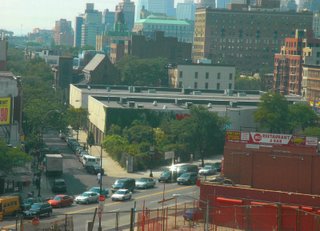 When I wrote earlier this month about the Brooklyn Bear's Garden adjacent to the Modell's and P.C. Richard on Site 5, I noted that, when Forest City Ratner acquired the land for the big box stores in 1997, the city retained development rights beyond the elevations of the planned buildings.
When I wrote earlier this month about the Brooklyn Bear's Garden adjacent to the Modell's and P.C. Richard on Site 5, I noted that, when Forest City Ratner acquired the land for the big box stores in 1997, the city retained development rights beyond the elevations of the planned buildings. Some 308,000 square feet of development rights remained. Did Forest City Ratner get those additional rights a long time ago in a negotiation with the city? No. It turns out that those rights were transferred, along with 328,272 square feet from the Atlantic Center mall in a Memorandum of Understanding (MOU) dated 2/18/05 but not revealed until August 2005, when Develop Don't Destroy Brooklyn publicized the memo it had acquired.
It's the city
 The language of the MOU is vague, but the confirmation is in Chapter 20, Alternatives, of the Atlantic Yards Draft Environmental Impact Statement. On p. 13, it states:
The language of the MOU is vague, but the confirmation is in Chapter 20, Alternatives, of the Atlantic Yards Draft Environmental Impact Statement. On p. 13, it states:Block 927 contains two active businesses in two separate one-story structures. Although higher density development could be achieved given its C6-2 zoning, the City of New York owns the air rights on this site. Therefore, higher-density development could not occur on Block 927 without City approval.
That makes it sound like a huge hurdle, but the city of New York has never attempted to seek development for the site. (Above at right, a rendering of the building planned at Site 5. The arrow points to the garden.)
Blame the city for blight
According to the Blight Study that's part of the General Project Plan, the site was found blighted in the 1960s:
Block 927 is located within ATURA, an area that, as described above, was found by the City to be blighted over 40 years ago. The block is zoned C6-2, a zoning designation that allows for a wide range of high-bulk commercial uses requiring a central location (see Figure 7). C6 districts typically accommodate uses such as corporate headquarters, large hotels, entertainment facilities, and mixed use buildings containing residential, retail, or other commercial uses.
The reason, the study concludes, is underutilization C66:
Lot 1 is in a C6-2 zoning district with an FAR of 6.0. Situated at the corner of 4th and Atlantic Avenues, the lot occupies a highly visible location in the shopping and employment concentration that is anchored by Atlantic Terminal and Atlantic Center. Although the 30,780 sf lot can accommodate up to 184,680 zsf of built space under current zoning, it hosts a single-story 30,300 gsf building, utilizing only about 16 percent of the lot’s development potential. At the time the lot was developed, the market conditions would not support a large-scale development using all of the development rights. As illustrated by Photograph B, the one-story PC Richard & Son building stands in stark contrast to the 34-story Williamsburg Savings Bank building (left), and the four stories of retail (center) and ten stories of office space (right) at Atlantic Terminal. Given its key location in the midst of one of the largest commercial districts in Brooklyn, lot 1 is critically underutilized.
(Emphasis added)
The same determination is made for the adjacent lot with the Modell's store.
Does the study assess the market conditions today or the city's failure to market the development rights? No.
Comments
Post a Comment